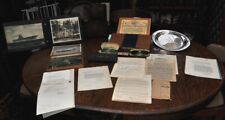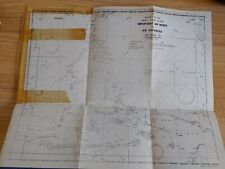Important WW2 & Prohibition Associated Sign From \"Carrollton Springs Distillery\"

When you click on links to various merchants on this site and make a purchase, this can result in this site earning a commission. Affiliate programs and affiliations include, but are not limited to, the eBay Partner Network.
Important WW2 & Prohibition Associated Sign From \"Carrollton Springs Distillery\":
$6000.00
Up for sale is an Important WW2 & Prohibition Associated Sign From \"Carrollton Springs Distillery\" which was located near Westminster Maryland and is a significant part of Baltimore, Maryland\'s Prohibition and World War Two History. Aside from the unique and really cool paint style and painting, it is believed that the sign was from the distillery founded in 1905 by Irish Immigrant Arthur McGinnis whom along with two other investors, built a distillery adjacent to the Western Maryland Railroad in a place called McGinnis Siding.
Arthur McGinnis renamed the place that was about 4 miles from the town of Westminster Maryland, \"Carrolton\" to identify the place with John Carrol, Maryland\'s signer of the Declaration of Independence. McGinnis died shortly thereafter but the distillery remained.
During World War two, research shows that The Carrollton Springs Pure Rye Distillery was an authorized federally funded facility that provided Ethyl Alcohol, 190 Proof, as a War Product to the US War Effort. The distillery no longer survives and there are no records that could be found after the war so it is likely the distillery closed shortly after the business ended that resulted from the War Effort.
The age of the sign in unknown but is typical of the style, design and paints used during the first quarter of the 1900\'s, most likely circa 1910\'s-1930\'s.The sign is in good condition for its age with a full description provided in details above. It is a nice large size,measuringslightly over 4 feet at approximately 50\" Length x 4 3/8\" Tall x 1/2\" Thick. It has two drilled holes on each side where it would slide over wooden pegs to stand upright. One could easily glue pegs to the top or a bar backing, glass cabinet, or create two simple feet with pegs standing up to sliding it on to display it upright in a home or tavern. Its a really unique and nice looking piece with great history. Please read the biographical information below about Arthur McGinnis which I found that led to the origins of the Distillery from the pre-pro whisky men blog and learn about the Great Whiskey Heist of 1926!
Free domestic US shipping includes insurance to your door.
Thanks for looking and please see my other listings for more unique one of a kind premium antiques and historical items added daily!
Arthur McGinnis and the Great Whiskey Heist
In early January 1926, as many as 50 men entered the government-held liquor warehouse of the McGinnis Distillery near Baltimore and hauled away 71 barrels and 32 cases of aged rye whiskey, with a present day value of almost a million dollars. It was the kind of bold caper that Arthur McGinnis, founder of the distillery and 21 years dead, might well have admired.
Arthur himself was a bold man. An immigrant from Ireland he began his American career during the 1870s as a wagoner, like the one shown here, working out of the east side of Baltimore.
His intelligence and “go getter” attitude brought him to the attention John B. Brown, the owner of a successful liquor outfit Brown had founded in 1869. The company Flagship brand was Brown’s Malt Whiskey which the owner merchandised as a medicinal beverage. An 1891 ad, shown here, asserted: \"Brown\'s Malt Whiskey is a cure for Indigestion, Brown\'s Malt Whiskey is a Tonic and Invigorant, Brown\'s Malt Whiskey is a Healthful Beverage, Brown\'s Malt Whiskey is a Genuine Distillation, Brown\'s Malt Whiskey is used by all Classes\"
Brown hired McGinnis in the mid-1880’s and taught him the liquor business. One of Brown’s sons, J. Badger Brown, was involved with the company but appears to have died early. In any case in 1895 the name of the firm became Brown, McGinnis & Company. McGinnis’s three sons -- John, James and Patrick -- all became involved in the business. This firm appears to have bottled and sold wine as well as whiskey. By 1905, Brown’s name had disappeared entirely and the A. McGinnis Company of Baltimore emerged.
McGinnis reorganized the company and invested $5,000. Other incorporators included sons John and James along with two other Irish compatriots, Martin O’Connor and Patrick McGrath. With the new infusion of funds McGinnis built a distillery adjacent to the Western Maryland Railroad at a place that came to be called McGinnis Siding. It was located four miles from Westminster, Maryland, but Arthur chose to name the site “Carrollton.” This identified the location with John Carroll, the state’s signer of the Declaration of Independence. The place existed only in Arthur’s rich Irish imagination. McGinnis Company offices remained in Baltimore, first at 208 Lexington Av. and then in the American Building downtown, shown here
Almost from the beginning, the whiskey business was successful and McGinnis Rye enjoyed strong regional sales. In 1905, the State Tax Commissioner set the taxable value of distilled spirits for the McGinnis Co. at $13,368. By 1907 that figure had grown to $21,496, and by 1909 had jumped to $62,760. Even with this growth the McGinnis distillery was among Maryland’s smaller operations, able to process only a relatively modest 250 barrels of mash per day.
The whiskey was bottled in a range of readily identified containers. McGinnis labeled square quarts bottles could be found in both clear and amber. All were embossed with the name of the distillery. McGinnis Pure Rye also came in flask sizes and an embossed miniature bottle. The firm issued merchandising items including shot glasses. One attractive example simply has the name etched in script. Another included a more elaborate firm logo, as shown in a drawing.
In November 1905, Arthur was injured in an accident and after lingering for a few weeks, died. His death triggered not only tumult at the A. McGinnis Co. but a legal dispute that fractured his family. The attempt to settle his estate required investigation of the balance sheets of the distillery. Except there weren’t any. As his son James told the court, Arthur “carried a bank book and a little stub. He carrried the bank book in his pocket and the cashbook in his head. That is how he ran the business.”
As a court determination later stated, McGinnis’s business was a success but, “the financial part of the concern was managed in a most loose and careless fashion.” Arthur’s recklessness engendered legal actions that pitted Mary McGinnis (probably his widow) and son James against son John and other investors. After the case reached the Maryland Supreme court a settlement was made among the McGinnises.
What happened then is not entirely clear even to their descendants. Apparently James and John mended their differences. Brother Patrick entered the picture as a whiskey executive. A Baltimore company called McGinnis Brothers was created in 1905 and existed along side the A. McGinnis & Company until Prohibition shut both of them down in 1920. At the time the McGinnis distillery was still operating and its warehouses were full of aging whiskey. The facility was put under U.S. Government control and the product was extracted in small amounts to be sold for allowable “medicinal purposes.”
On that fateful winter afternoon, according to witnesses, three men, earlier seen ice skating on a nearby pond, suddenly confronted a government guard. They drew pistols and tied him up. The next to be trundled was an 80-year-old man who had wandered by the scene looking for his lost cat. In time some seven guards and watchmen were shackled and a gang, estimated at from 40 to 50 men, made themselves at home in the distillery for 15 hours.
Taking all night, by dawn they had loaded five trucks with 71 barrels of the oldest whiskey and 32 cases of bottled stock. The total value of the liquor at the time was estimated at $90,000 --- close to a million dollars today. Federal officials later traced the trucks, now accompanied by mobsters in automobiles, south to Mexico. .
In April of that year, seven men were charged with the crime after being caught transporting carloads of beer into Baltimore via railroad. The record does not reveal if they ultimately were found guilty. Nevertheless, taking no more chances, Federal officials moved the remaining whiskey to another location and, in October 1926, brick by brick, tore down the distillery that Arthur McGinnis had built, and sent the building materials to New York.
Story style=\"text-align: left; margin: 0px; line-height: normal; font-family: Helvetica; -webkit-text-stroke-width: initial; -webkit-text-stroke-color: rgb(0, 0, 0);\">Research Credit: Heritage Research online library for WW2 data on Carrollton Springs Pure Rye Distillery
Important WW2 & Prohibition Associated Sign From \"Carrollton Springs Distillery\":
$6000.00

Related Items:
Important WW2 & Prohibition Associated Sign From "Carrollton Springs Distillery"
$6000.00
Important lot WW2 Naval Aviator Lt. CMDR awards, photos, docs, bag, glasses etc.
$5000.00
WW2 Air Force Pacific Fleet Important Air Base & Distance Chart 5 Feb 15 1944Map
$195.00







